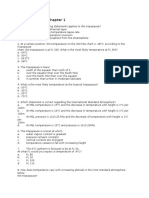Meteorology
Meteorology
Uploaded by
Maria Luiza Cancio PadilhaCopyright:
Available Formats
Meteorology
Meteorology
Uploaded by
Maria Luiza Cancio PadilhaCopyright
Available Formats
Share this document
Did you find this document useful?
Is this content inappropriate?
Copyright:
Available Formats
Meteorology
Meteorology
Uploaded by
Maria Luiza Cancio PadilhaCopyright:
Available Formats
METEOROLOGY
At a certain position, the temperature on the 300 hPa chart is -48C; according to the tropopause chart, the tropopause is at FL 330. What is the most likely temperature at FL 350 ? 300hPa = 30,000 ft (FL300). The temperature falls at 2C per 1,000ft to be -54C at FL330, the tropopause. Above FL330 the temperature is constant. Which FL corresponds with the 200 hPa pressure level ? FL 390. 200hPa = FL390 is worth remembering. What is the approximate vertical interval which is equal to a pressure change of 1 hPa at an altitude of 5500 m ? At mean sea level 1hPa = 8m (27ft). At 5,500m (18,000ft) 1hPa = 15m (50ft) and at 12,000m (39,000ft) 1hPa = 32 m (105 FT). In order to calculate QFE from QNH, which of the following must be known ? Elevation of the airfield. QNH is QFE reduced to sea level assuming ISA conditions so to calculate QFE from QNH we only need to know field elevation. What is the dry adiabatic lapse rate ? 3C/1,000ft or 1C/100m. A layer is conditionally unstable if the air... Is unstable for saturated air and stable for dry air. Lapse rate between 1.8C and 3C per 1,000ft. A parcel of unsaturated air is lifted to just below the condensation level and then returned to its original level. What is the final temperature of the parcel of air? The same as the starting temperature. It goes up cooling at the DALR and comes down warming at the DALR . What is the effect of a strong low level inversion ? It promotes vertical windshear. An inversion means very stable conditions and, therefore, poor visibility. However, it does produce wind shear between different levels. The temperature at FL 140 is -12C. What will the temperature be at FL 110 if the ICAO standard lapse rate is applied ? -6oC. FL140 = -12C 3 x 2C/1,000ft + 6C FL110 = -6C. If atmospheric conditions exist such that the temperature deviation is ISA +10C in the lower troposphere up to 18000 FT, what is the actual layer thickness between FL 60 and FL 120 ? 6240FT The difference between the 6,000ft pressure depth and the depth of a standard atmosphere will be 4ft per 1,000ft per C deviation = 4 x 6 x 10 = 240ft. The actual depth of the layer between FL60 and FL120 = 6,000 + 240 = 6,240ft. Which of the following is a common cause of ground or surface temperature inversion ? Terrestrial radiation on a clear night with no or very light winds. It gets cold near the surface and stays warm above. This is a temperature inversion.
How does the height of the tropopause normally vary with latitude in the northern hemisphere ? It decreases from south to north. The tropopause is higher over the equator and lower over the Poles. What, approximately, is the average height of the tropopause over the equator ? 16KM. The average height of the tropopause across the globe is 11km; lower at the poles and higher at the equator, but 40km is far too high. In which layer is most of the atmospheric humidity concentrated ? Troposphere. Higher, colder air holds little moisture. At FL 180, the air temperature is -35C.The air density at this level is: Greater than the density of the ISA at FL180. At FL180 in a standard atmosphere, the temperature is (+15 2x18) = -21C. If the temperature is colder than ISA, the air will be denser than ISA. Under what condition does pressure altitude have the same value as density altitude ? At standard temperature. Density altitude is only the same as pressure altitude in standard atmosphere conditions. In the troposphere the decrease in pressure per 100 m increase in height is: Larger in the lower layers than in the higher layers. The rate of change of pressure is not linear, it is logarithmic. It is much greater near the surface than at altitude. It is about 27ft/hPa at sea level but 110ft/hPa at 40,000ft. In temperate latitudes what weather conditions may be expected over land during the summer in the centre of a stationary high pressure zone ? Calm winds, haze. High pressure is associated with stable air; no significant cloud, no cumulus, light winds and poor visibility. At what time of the year, are the paths of north Atlantic lows moving from west to east generally at their most southerly position? Winter. Florida to Folkstone in the winter and Newfoundland to Norway in the summer. What is the relationship between visibility and RVR in homogeneous fog? The visibility is generally less than the RVR.
You might also like
- Meteorology AtplDocument17 pagesMeteorology AtplJavier Moreno Rodríguez100% (5)
- QDB 15 MeteorologyDocument233 pagesQDB 15 MeteorologyZbor Zbor100% (5)
- ATPL (A) Meteorology SummaryDocument174 pagesATPL (A) Meteorology Summarywilliambasket990% (1)
- Met Corrected PDFDocument87 pagesMet Corrected PDFRaveena Sharma100% (1)
- 9 - CPL Questions MeteorologyDocument99 pages9 - CPL Questions MeteorologyMoshiurRahman50% (2)
- QDB 15 PerformanceDocument48 pagesQDB 15 PerformanceKueh Chew Chai90% (10)
- ATPL Met Study NotesDocument49 pagesATPL Met Study NotesPhil82% (11)
- Altimeter Practice Question1Document4 pagesAltimeter Practice Question1Rohit100% (1)
- Meteorology (Questions) For CPL - ATPL - Subjects For CPL and ATPLDocument4 pagesMeteorology (Questions) For CPL - ATPL - Subjects For CPL and ATPLSojin Soman100% (4)
- ATPL - EASA2016 - MeteorologyDocument70 pagesATPL - EASA2016 - MeteorologyNuno Arnaud100% (2)
- Instruments Keith WilliamsDocument92 pagesInstruments Keith WilliamsPreet GonsalvesNo ratings yet
- MET Question BankDocument136 pagesMET Question BankIvan100% (1)
- Examen MeteorologiaDocument185 pagesExamen MeteorologiaYuvaraj UdayagiriNo ratings yet
- 1 in 60 RuleDocument8 pages1 in 60 Rulevivek100% (1)
- QDB 15 Radio NavDocument83 pagesQDB 15 Radio NavKueh Chew Chai100% (13)
- QDB 15 Operational ProceduresDocument66 pagesQDB 15 Operational ProceduresKueh Chew Chai100% (10)
- 022 Instrumentation - V2+v3 - 31OUT09Document136 pages022 Instrumentation - V2+v3 - 31OUT09kest32100% (1)
- Air RegulationDocument35 pagesAir RegulationsudhirvatsaNo ratings yet
- ATPL Sample Questions - Radio AidsDocument5 pagesATPL Sample Questions - Radio AidsAbhinaya Sekar100% (2)
- QDB 15 HPLDocument103 pagesQDB 15 HPLKueh Chew Chai100% (5)
- 031 Mass and BalanceDocument173 pages031 Mass and BalanceMay Be100% (4)
- GNAV Questions by LessonDocument83 pagesGNAV Questions by LessonLucasNo ratings yet
- Surinder Reg QBDocument44 pagesSurinder Reg QBtopgun320100% (2)
- Scalar Wave Medicine PDFDocument20 pagesScalar Wave Medicine PDFsadiku100% (2)
- Power Problems and UPS SolutionsDocument2 pagesPower Problems and UPS Solutionsdrastir_777100% (1)
- Meteorology AtplDocument27 pagesMeteorology Atpledward davisNo ratings yet
- Met Question Bank PDFDocument68 pagesMet Question Bank PDFAnandhanNo ratings yet
- 9 - ATPL Questions MeteorologyDocument99 pages9 - ATPL Questions MeteorologyRitwik Chowdhury100% (1)
- 1000 Question Instruments-Chapwise Wid AnsDocument42 pages1000 Question Instruments-Chapwise Wid AnsMontel Berreto100% (2)
- Navigation 03 of FC 2022Document11 pagesNavigation 03 of FC 2022Yuvraj Singh 2》100% (2)
- Atmosphere - QuestionDocument25 pagesAtmosphere - QuestionAvinash VijaykumarNo ratings yet
- CPL - Principles of FlightDocument5 pagesCPL - Principles of FlightYsl2kNo ratings yet
- General Navigation Questions PDFDocument242 pagesGeneral Navigation Questions PDFKaran Singh100% (2)
- DGCA Meteorology QuestionDocument2 pagesDGCA Meteorology QuestionShibin Johney100% (1)
- 050 - Meteorology (1650 Q)Document250 pages050 - Meteorology (1650 Q)obrajior100% (3)
- Flight Planning & Flight MonitoringDocument2 pagesFlight Planning & Flight MonitoringNat ChuenjumlongNo ratings yet
- 11 - CPL Questions Rad NavigationDocument73 pages11 - CPL Questions Rad NavigationMoshiurRahman100% (2)
- Albatross - Regs QBDocument47 pagesAlbatross - Regs QBtopgun320100% (1)
- Volare Questions - Mass and BalanceDocument33 pagesVolare Questions - Mass and BalanceCdr. Pearl50% (2)
- QDB 15 Ifr & VFRDocument14 pagesQDB 15 Ifr & VFRKueh Chew Chai100% (4)
- Surender Conv of Units (10 Files Merged)Document25 pagesSurender Conv of Units (10 Files Merged)Anmoldeep SinghNo ratings yet
- Few Q's On PayloadsDocument5 pagesFew Q's On PayloadsAnuj ShahNo ratings yet
- Air Navigation Test No.3Document15 pagesAir Navigation Test No.3Vivek ChandraNo ratings yet
- Met Q OxfordDocument158 pagesMet Q OxfordEagle NavNo ratings yet
- Examen Meteorologia 1 PDFDocument185 pagesExamen Meteorologia 1 PDFtahirh1985No ratings yet
- Atpl - Meteorology SetDocument5 pagesAtpl - Meteorology SetHamidK.FarhatNo ratings yet
- Principles of FlightDocument269 pagesPrinciples of Flight7ThorHimmel100% (2)
- Airnav CPLDocument4 pagesAirnav CPLshombisNo ratings yet
- Quizlet-Com-668523Document52 pagesQuizlet-Com-668523DawitNo ratings yet
- QDB 15 MeteorologyDocument233 pagesQDB 15 MeteorologyKueh Chew Chai96% (25)
- ATPL Met NotesDocument22 pagesATPL Met Notesjanine Goncalves100% (2)
- DGCA QDB 15 MeteorologyDocument233 pagesDGCA QDB 15 MeteorologyManan TyagiNo ratings yet
- MET SummaryDocument33 pagesMET SummarymatisseherzeleNo ratings yet
- Class NotesDocument11 pagesClass Notesstephenvarga09No ratings yet
- Meteorology Dauletova AidinaDocument45 pagesMeteorology Dauletova Aidinaaydina.dauletovaNo ratings yet
- AtomospherrDocument7 pagesAtomospherrCaptain b7No ratings yet
- Chapter 8Document5 pagesChapter 8CHI SANG TANGNo ratings yet
- Let's Get Started - Ground School: Weather & MeteorologyDocument42 pagesLet's Get Started - Ground School: Weather & MeteorologyNirgunaRamkissoonNo ratings yet
- Meteo 2016Document4 pagesMeteo 2016edward davisNo ratings yet
- Met1 PDFDocument6 pagesMet1 PDFRaveena SharmaNo ratings yet
- Some Atypical Properties of Beryllium Compounds - Chemistry LibretextsDocument6 pagesSome Atypical Properties of Beryllium Compounds - Chemistry Libretextsapi-368121935No ratings yet
- Budget of Work PR2 2nd QTRDocument4 pagesBudget of Work PR2 2nd QTRAngela Francisca Bajamundi-VelosoNo ratings yet
- Barley WaterDocument18 pagesBarley WaterravilattooNo ratings yet
- M1 Quiz PDFDocument13 pagesM1 Quiz PDFShawn MichaelNo ratings yet
- L&T Level 3 Tq-Catalogue PDFDocument10 pagesL&T Level 3 Tq-Catalogue PDFanujpkr5118No ratings yet
- Federal Employees Farewell GrantDocument2 pagesFederal Employees Farewell Grantabubakar younasNo ratings yet
- LaserWash 360 Plus Remote Control Quick ReferenceDocument2 pagesLaserWash 360 Plus Remote Control Quick ReferenceAathi MudhaliyarNo ratings yet
- Reach & Rohs Material Declaration of Conformity: The Harris Products GroupDocument2 pagesReach & Rohs Material Declaration of Conformity: The Harris Products GroupTowfiq AhmedNo ratings yet
- Poly Vinyl Chloride Plant PresentationDocument23 pagesPoly Vinyl Chloride Plant PresentationbharatmorwaniNo ratings yet
- Ascending and Descending Tracts of The Spinal CordDocument11 pagesAscending and Descending Tracts of The Spinal CordNabila UsmanNo ratings yet
- Venditti - ASH 2023 - Ven in Elderly Patients Poster With COIs - 13nov2023Document1 pageVenditti - ASH 2023 - Ven in Elderly Patients Poster With COIs - 13nov2023molly.kottemannNo ratings yet
- Injection Mold Set-Up Technician Job ProfileDocument2 pagesInjection Mold Set-Up Technician Job ProfileJonquil NorrieNo ratings yet
- To Make Gado-Gado (Vegetable Salad With Peanut Sauce)Document3 pagesTo Make Gado-Gado (Vegetable Salad With Peanut Sauce)Arief SasiadiNo ratings yet
- 429337B - Top Loaders - User Install - NZAUSGROW PDFDocument56 pages429337B - Top Loaders - User Install - NZAUSGROW PDFeyas tNo ratings yet
- Complaints Against Shift Vans's DriversDocument3 pagesComplaints Against Shift Vans's DriversNaveed Ul Qamar MughalNo ratings yet
- Mandoon Estate Meeting Packages 2023 4Document19 pagesMandoon Estate Meeting Packages 2023 4AnishNo ratings yet
- Reg Section 1.864-2Document5 pagesReg Section 1.864-2EDC AdminNo ratings yet
- Chocolate Analysis: Nischay Sharma 12-A 9Document14 pagesChocolate Analysis: Nischay Sharma 12-A 9Rishabh SharmaNo ratings yet
- GaAs Crystal Growth TechniquesDocument20 pagesGaAs Crystal Growth TechniquesdilaawaizNo ratings yet
- 3 - Planigrout 300 SP - SGDocument4 pages3 - Planigrout 300 SP - SGyaw shuNo ratings yet
- Creative Thinking and InnovationDocument16 pagesCreative Thinking and InnovationCerasela Iuliana PienoiuNo ratings yet
- Santuyo vs. Remerco Garments Vol. Arbitrator Jurisdiction 2010Document8 pagesSantuyo vs. Remerco Garments Vol. Arbitrator Jurisdiction 2010Ulysses RallonNo ratings yet
- Lab Report WebsiteDocument7 pagesLab Report Websiteapi-548925295No ratings yet
- TT105Document4 pagesTT105mr_fixitOKNo ratings yet
- 2009 LABOR Case DigestDocument80 pages2009 LABOR Case DigestIrish PDNo ratings yet
- LPL - Rakesh FPSC Shalimar Bagh-4 H. No. 169, AA-Block, Shalimar Bagh, New Delhi-110088. No-7210779305 Delhi 110088Document4 pagesLPL - Rakesh FPSC Shalimar Bagh-4 H. No. 169, AA-Block, Shalimar Bagh, New Delhi-110088. No-7210779305 Delhi 110088Lakshav KapoorNo ratings yet
- A750e ShudderDocument6 pagesA750e ShudderTanya Daniel75% (4)
- "Brimming River" (Usbaw Sa Suba)Document20 pages"Brimming River" (Usbaw Sa Suba)Aubry GucorNo ratings yet

























































































